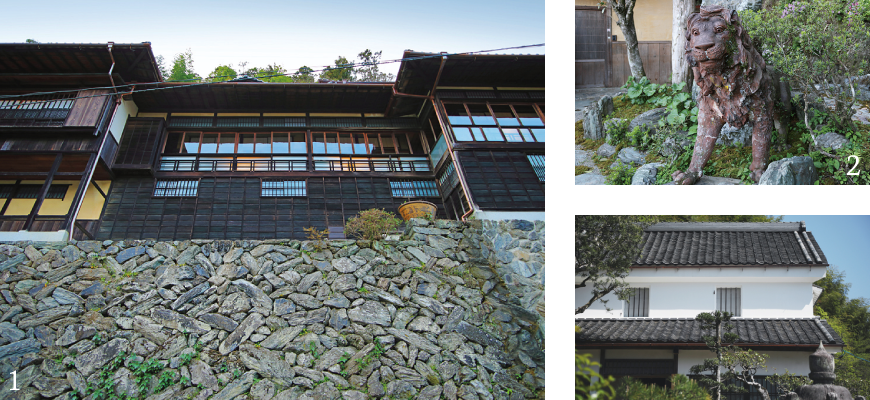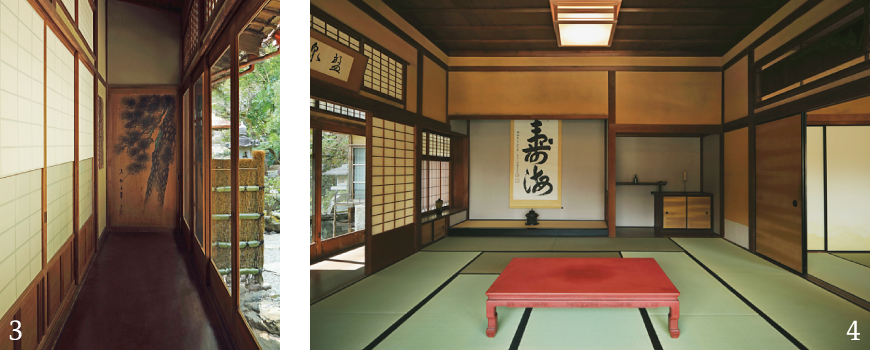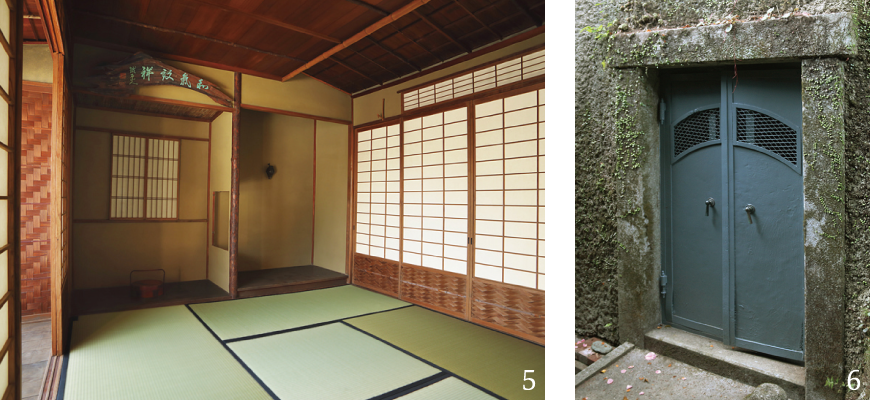盤泉荘
盤泉荘の由来
フィリピンでの貿易で富をなした松井家の、国際色豊かな名建築
松井傳三郎(1870~1920)・國五郎(1875~1945)兄弟は、マニラで貿易会社を経営し、日本人移民向けの百貨店も経営するなど貿易・小売業で大きな財を成した。盤泉荘(旧松井家住宅)は、傳三郎が故郷の大洲に別荘を建築しようと計画し、その遺志を継いだ國五郎が大正15(1926)年に完成させた。住宅は、肱川随一の景勝地と称された臥龍や冨士山、亀山など自然豊かな景観を見渡す高台に立地する。建材には東南アジアから輸入された南洋材が使用されているほか、当時の日本家屋には珍しいバルコニーや施主のイニシャル「K. M」がデザインされた鬼瓦が採用されるなど、貿易業を営んだ施主らしい国際性豊かな特徴を随所に見ることができる。裏山の岩盤からしみ出す水を利用していたことから「盤泉荘」とも呼ばれた。


1 外観・石積み
高台の急斜面からせり出すように建つ木造3階建の荘厳な姿は、建築当初から地域の代表的なランドマークとして存在し続けており、現在の町並みの景観形成においても貴重な存在である。また、象徴的な石積みは、現地周辺で切り出した石をX状にリズミカルに積み上げる独特のもの。主屋との一体感を持たせており、デザイン性が高い。
2ライオン像
前庭には、新やなせ焼のライオンの像が置かれている。新やなせ焼は、かつて江戸中期にできた柳瀬焼が廃絶後、大正10年に大洲の有志数名の発起で復興されたやきものだ。

3 廊下
フィリピン等を原産とし、その重さや硬さから「太平洋鉄木」と称される南洋材イピール。その木材を丁寧に仕上げた長大な一枚板が20枚連続する廊下は、客人を座敷・客間・茶室へと誘うレッドカーペット。客人用の動線と日常生活の動線の区別は一目瞭然で、一枚板の連続に対して小幅な床板となっている。
4 一階座敷
高い天井に筬欄間、無節の檜材に黒漆塗で仕上げられた床框・違い棚・付書院に見られるのは、簡潔でありながら荘厳な座敷飾り。非常に格式の高い伝統的書院造の形を表している。

5 茶室・化粧室
茶室は、網代建具や赤松皮付床柱、舟板の古材を使うなど、手の込んだ細工がみられ、浴室には、大正年間には珍しい女性への配慮(入浴後、客人の前に出る前に整えられる)が感じられる。
6 横井戸
奥に向けて50m以上掘られており、井戸の奥から流れ込んできた水が、台所に設けられた貯水槽に送られる仕組みになっている。これは上水道が整備されていない大正期に生活用水を確保するために整備されたもので、この水の確保があったからこそ盤泉荘は建築されたと推察される。
詳しくは観光案内所にご連絡ください。
周辺の地図
周辺のお薦め
観光施設
自然・名所
大洲城下町の町並み
大洲肱南エリアまち歩きMAP 城下町の名建築 再生された古民家ショップ・ホテル 駐...
詳しく見る
体験
観光施設
大洲城
日本最大級の木造復元天守2004年の天守の木造復元以降、大洲市のシンボルとして大洲の中心...
詳しく見る
観光施設
臥龍山荘
粋を極めた数奇屋造りの名建築青く澄みわたる臥龍淵の水面には、新緑や紅葉が鏡のように映る。...
詳しく見る
観光施設
盤泉荘
盤泉荘の由来フィリピンでの貿易で富をなした松井家の、国際色豊かな名建築松井傳三郎(187...
詳しく見る
土産
観光施設
おおず赤煉瓦館
1901年に大洲商業銀行の本店として建築された。建物は主にイギリス積みの煉瓦建築で、屋根...
詳しく見る
体験
観光施設
土産
大洲まちの駅あさもや・大洲観光総合案内所
大洲地域の特産物を販売する物販施設。無料の駐車場も兼ね備えているため、大洲観光の拠点にお...
詳しく見る
観光施設
伊予大洲駅観光案内所
伊予大洲駅観光案内所は2019年4月19日(金)に観光案内所及び物販施設としてオープン。...
詳しく見る
体験
NIPPONIAHOTEL大洲城下町
今昔の建築美が織り交ざった古民家ホテルは、歴史的な邸宅が改装されたもの。邸宅時代のしつら...
詳しく見る
自然・名所
大洲神社
大洲城の東方面にある神楽山に鎮座し、大洲藩代々の崇敬を集めてきた由緒ある神社。1331年...
詳しく見る
自然・名所
おはなはん通り
江戸時代の町割と家並等が忠実に残された地域で、当時の暮らしぶりを垣間見ることができる。北...
詳しく見る
自然・名所
少彦名神社
古事記や日本書紀に登場する少彦名命(日本神話の神)の終焉とされる地を崇敬するために建てら...
詳しく見る
観光施設
体験
ポコペン横丁
昔、誰もが遊んだ缶けりやかくれんぼ。あの懐かしさが漂う昭和30年代の雰囲気が再現されてい...
詳しく見る


